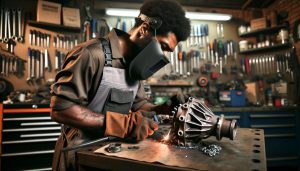When it comes to quick and effective repairs, JB Weld is a household name that has gained a loyal following among DIY enthusiasts and professionals alike. Known for its impressive bonding strength, this two-part epoxy has been a go-to solution for everything from fixing metal components to mending ceramic and plastic. With over 1,000 applications tested under various conditions, we dive deep into the true capabilities of JB Weld, examining its durability, ease of use, and versatility. Whether you’re an experienced welder looking for reliable repair solutions or a beginner trying to tackle your first project, understanding how JB Weld performs can save you time, money, and frustration. Join us as we uncover the honest truth about JB Weld, shedding light on its strengths and potential limitations, so you can make informed decisions in your next repair endeavor.
How JB Weld Works: A Closer Look at Its Composition
JB Weld is widely regarded as a reliable and versatile adhesive for a variety of materials, but its effectiveness stems from its unique chemical composition. At its core, JB Weld is an epoxy, a thermosetting polymer that forms a strong bond through a chemical reaction between its resin and hardener components. When mixed in equal parts, these two elements undergo an exothermic reaction, leading to the formation of a durable bond that can withstand high temperatures and pressures.
The primary ingredients in JB Weld include epoxy resin, hardeners, and fillers that enhance its performance characteristics. The epoxy resin provides structural strength, while the hardeners ensure that the bond cures correctly and achieves a robust and lasting hold on surfaces. The fillers, often made from materials such as aluminum or silica, not only improve the adhesive’s consistency but also contribute to its resistance against thermal expansion and contraction. This dual-action formulation results in a product that, once cured, can endure temperatures up to 550°F (287°C), making it suitable for high-stress environments.
In practical applications, the benefits of JB Weld’s composition are evident. For example, automotive repairs often involve fixing cracks in engine blocks or exhaust systems. The high-temperature resistance and exceptional bonding strength of JB Weld make it an ideal choice for such scenarios. Additionally, its ability to bond with metals, plastics, ceramics, and wood makes it an all-purpose adhesive for both professional welders and DIY enthusiasts. Understanding how JB Weld works at a fundamental level allows users to leverage its properties effectively, ensuring strong and reliable repairs across countless applications.
By focusing on the specifics of JB Weld’s composition, users can appreciate its role not just as an adhesive, but as a critical tool in their repair arsenal. Whether tackling home projects or professional welds, knowing the science behind JB Weld can lead to optimized usage and superior results.
Real-Life Applications of JB Weld: Success Stories
The versatility of JB Weld is exemplified through numerous success stories across various industries and applications. Its ability to create strong, lasting bonds has saved countless projects from failure, providing solutions where traditional welding methods may not have been feasible. For instance, automotive enthusiasts frequently turn to JB Weld for complex repairs. One notable case involved a cracked engine block in a vintage car. Instead of costly replacement, the owner applied JB Weld to the fracture, allowing the vehicle to run smoothly for years thereafter, thus proving the adhesive’s capability to withstand extreme heat and pressure.
In the realm of home repairs, JB Weld shines as well. Homeowners have successfully used it to mend broken ceramic statues, restore damaged plumbing fixtures, and even fix chipped countertops. In one example, a homeowner utilized JB Weld to repair a leaking pipe fitting, achieving a waterproof seal that lasted through multiple freeze-thaw cycles. This adaptability is a testament to JB Weld’s reliability, particularly when traditional soldering or welding is not an option or would require disassembly of complicated structures.
The flexibility of JB Weld also extends to crafting and DIY projects. Crafters have embraced it for assembling metal sculptures, affixing components in jewelry making, and even building custom tools. The ability to bond dissimilar materials such as metals to plastics or ceramics allows artists and makers to push the boundaries of their creativity without being limited by adhesive constraints. For example, an artist utilized JB Weld to assemble intricate metalwork for an outdoor sculpture, ensuring durability against the elements.
Moreover, the impressive performance of JB Weld in severe conditions is often highlighted by users tackling repairs in aerospace or marine applications. For instance, a marine technician reported using JB Weld to fix a crucial part of a boat engine that would have otherwise required expensive repairs. This repair not only showcased the adhesive’s strength but also highlighted its resistance to corrosion, making it ideal for environments prone to moisture and salt.
In summary, the real-life applications of JB Weld demonstrate its effectiveness and reliability across diverse scenarios, from automotive and home repairs to creative projects and industrial fixes. These success stories serve as powerful endorsements, encouraging both beginners and seasoned professionals to consider JB Weld as a go-to solution for challenging bonding tasks.
Common Mistakes Using JB Weld and How to Avoid Them
Using JB Weld effectively requires more than just mixing its components and applying it to the problem area; several common mistakes can lead to less-than-ideal results. One major pitfall occurs when users rush through the preparation of the surfaces. JB Weld creates a strong bond on cleaned and roughened surfaces, yet many overlook this step. To maximize adhesion, ensure that all dirt, grease, and paint are removed, and lightly sand or scuff the area to create a better mechanical grip. Skipping this essential process can lead to premature failure of the bond, especially under stress or heat.
Another frequent error is improper mixing of the two components. JB Weld consists of a resin and a hardener that must be mixed in equal parts for optimal performance. However, users sometimes eyeball the amount or fail to mix sufficiently, resulting in a weaker bond. For best results, measure each component accurately using a clean mixing surface and stir thoroughly until the color is uniform. Remember that mixed JB Weld has a limited working time, so it should be applied promptly after preparation.
Timing is crucial during application as well. Many users mistakenly think waiting longer will allow for a more solid cure, yet providing adequate time for the initial set is important. JB Weld typically requires 4 to 6 hours to set and should ideally be left undisturbed for 24 hours to reach full strength. Avoid the temptation to force the bond during this curing time, as doing so can create weak points or cause the bond to fail entirely.
Lastly, there’s a misconception regarding JB Weld’s versatility with different materials. While it excels in bonding metals, it may not perform as well on certain plastics. Users often attempt repairs on low-energy surfaces or those not recommended by the manufacturer, leading to disappointing results. Always refer to JB Weld’s specifications to ensure that the materials you wish to bond fall within its capabilities, and when in doubt, consider doing a small test first.
In summary, avoiding these common mistakes-proper preparation, accurate mixing, adherence to curing times, and understanding material compatibility-can significantly enhance the success of JB Weld applications. By applying these practices, users can leverage the full potential of this reliable adhesive to achieve durable and long-lasting repairs.
JB Weld vs. Traditional Welding: Pros and Cons
Traditional welding and JB Weld both serve the critical function of joining materials, but they are fundamentally different processes that come with their own sets of advantages and drawbacks. When considering repair or fabrication options, understanding the nuances of each method can help in choosing the right approach depending on the application.
To begin with, traditional welding-using methods like MIG, TIG, or stick welding-creates a permanent bond by melting base materials and introducing filler material, resulting in a molecular bond. This can lead to exceptionally strong joints, particularly in applications requiring high strength and structural integrity, such as in construction or automotive repairs. However, traditional welding requires specific skills, equipment, and safety precautions. It can generate significant heat, which can warp and damage materials if not controlled carefully.
In contrast, JB Weld offers a user-friendly alternative, especially for smaller repairs or less critical applications. This epoxy adhesive bonds at room temperature, making it accessible for DIY enthusiasts and professionals alike without the need for specialized equipment. It can effectively bond various materials like metals, ceramics, and some plastics, providing a solid hold for many repair tasks. However, while JB Weld is resilient, it may not match the load-bearing capabilities of welded joints, particularly in high-stress environments. Additionally, its curing process can be hindered by moisture or contaminants on the surface, necessitating thorough preparation for optimal performance.
The choice between these methods often boils down to project requirements. For quick fixes, lightweight repairs, and home projects, JB Weld can be an efficient solution. On the other hand, for applications demanding high structural stress or where aesthetics are pivotal, traditional welding remains the gold standard. Each method has its place, and understanding the specific advantages of both can lead to better repair strategies and outcomes.
Durability Test: How Long Does JB Weld Last?
JB Weld is heralded not only for its ease of use but also for its impressive durability, offering longevity that makes it a favored choice for many DIY enthusiasts and professionals alike. Depending on the specific formula used (such as JB Weld, JB Quik, or JB WaterWeld), the lifespan of repairs performed with JB Weld can often exceed several decades when applied correctly and in ideal conditions.
The longevity of a JB Weld bond is influenced by various factors, including the environment in which it is placed and the materials being adhered. JB Weld is known for its excellent resistance to water, chemicals, and extreme temperatures, making it suitable for both indoor and outdoor applications. Typical uses include automotive repairs, household fixtures, and plumbing applications, where it can withstand mechanical stress, vibrations, and exposure to various substances without breaking down.
### Factors Affecting Durability
- Surface Preparation: Properly cleaning and preparing surfaces before applying JB Weld is crucial for durability. Any contaminants such as oil, moisture, or dust can significantly diminish the bond strength.
- Curing Conditions: Allowing JB Weld to fully cure according to the instructions contributes to its maximum strength. In general, JB Weld takes 4-6 hours to set and achieves full strength in 15-24 hours.
- Environmental Exposure: While JB Weld is designed to resist moisture and chemicals, extreme weather conditions can affect its performance over time. For prolonged exposure to harsh environments, protective coatings may be necessary.
### Real-World Performance
Users often report successful long-term performance of JB Weld in demanding situations, with many applications lasting for years without fail. For instance, automotive enthusiasts frequently utilize JB Weld for repairing engine components, where it not only seals leaks but can hold under high temperatures and stress. In the construction sphere, welders have utilized JB Weld as a temporary fix for piping systems until permanent solutions could be implemented, attesting to its reliability in critical scenarios.
In short, while JB Weld provides a robust adhesive capable of achieving durability that often rivals traditional welding in various applications, the longevity of its results ultimately hinges on correct application practices and environmental considerations. Understanding these dynamics can empower users to make informed decisions, ensuring repairs remain effective for as long as possible.
Application Techniques: Best Practices for Success
When engaging with JB Weld, a well-defined approach to application can greatly influence the strength and longevity of your repairs. Firstly, thorough surface preparation is critical. The surfaces to be bonded must be clean, dry, and free of any contaminants, such as dust, oil, or moisture. Use a degreaser for oily surfaces and a fine-grit sandpaper to roughen up smooth surfaces, which enhances adhesion by providing a larger surface area for the epoxy to grip onto. Ensuring that the materials are properly aligned before application can prevent misalignment during the curing process.
Once the surfaces are prepared, the mixing of the JB Weld components should be done carefully. Follow the manufacturer’s instructions for the correct ratio, usually a 1:1 mix of resin and hardener. Utilizing a clean mixing tool, combine the two until you achieve a uniform consistency. Applying the mixture should be done within the pot life of the epoxy (typically around 30 minutes), where the epoxy maintains proper workability without beginning to cure.
Curing Conditions and Techniques
Allowing the JB Weld to cure under optimal conditions cannot be overstated. For the best results, maintain the temperature around 70°F to 90°F, as extreme temperatures may impede proper curing. Protect the area from moisture during the curing period, which usually takes anywhere from 4 to 24 hours, depending on environmental factors. It’s advisable to cover the repair site or isolate it from drafts and excessive humidity. For deeper fills or thicker applications, a second layer of JB Weld may be necessary, as the first layer can sometimes shrink or sag during the curing process.
Moreover, being mindful of the necessary pressure during the initial setting phase ensures that the surfaces maintain contact while minimizing gaps, which is essential for a strong bond. Once fully cured, JB Weld can withstand significant forces making it suitable for both minor and major repairs, whether in vehicles, plumbing, or household items. Adopting these best practices can significantly improve the performance and durability of your JB Weld applications.
Comparative Review: JB Weld vs. Competitors
When considering the efficacy of JB Weld, it is essential to compare it against its competitors in the adhesive and epoxy market. JB Weld has established itself as a leading choice for both professionals and DIY enthusiasts due to its remarkable bonding strength and versatility. However, multiple alternatives exist that may cater to specific needs or preferences, such as Loctite Epoxy, Gorilla Glue, and Permatex Epoxy. Each of these products brings unique features that influence their suitability for various applications.
One of the notable strengths of JB Weld lies in its temperature resistance, which can withstand heat up to 500°F once fully cured. This characteristic makes it ideal for automotive repairs, as parts exposed to high temperatures require a durable adhesive. In contrast, while a product like Loctite Epoxy offers good bonding capabilities, it is better suited for indoor applications where heat exposure is limited. Gorilla Glue, a polyurethane-based adhesive, is excellent for porous surfaces but lacks the rigorous mechanical strength and heat resistance of JB Weld, making it less effective for metal repairs.
Performance Metrics
To better understand how JB Weld stacks up against its competition, consider these performance metrics:
| Product | Max Temperature Resistance | Set Time | Typical Applications |
|---|---|---|---|
| JB Weld | 500°F | 4-24 hours (full cure in 15-24 hours) | Automotive, pipe repair, metal & plastics |
| Loctite Epoxy | 150°F | 20-30 minutes | Indoor repairs, wood, ceramics |
| Gorilla Glue | 200°F | 1-2 hours (full cure in 24 hours) | Wood, foam, ceramics |
| Permatex Epoxy | 250°F | 5-10 minutes | Automotive, repairs requiring quick bond |
Application Flexibility
JB Weld exceeds in versatility, being suitable for various materials including metals, wood, and plastics. Its two-part epoxy formula allows for deep fills, which can be critical when repairing gaps or holes in materials. Alternatives like Permatex may offer quick bonding times, but they can struggle with more complex applications requiring the robustness that JB Weld provides. Thus, for repairs demanding high structural integrity, JB Weld is often the preferred choice.
Ultimately, while JB Weld holds a strong position in the market for repairs that demand heat resistance and mechanical strength, the choice between it and its competitors depends on the specific needs of the project at hand. Whether for automotive repairs, DIY projects, or household fixes, understanding the nuances of each product will empower users to make informed decisions that best suit their requirements.
User Experiences: What Customers Are Saying
The testimonials and feedback from users who have employed JB Weld in a variety of applications reveal much about its effectiveness and versatility. Many customers rave about its strong bonding capabilities, often noting successful repairs on items that were previously deemed irreparable. One user shared a story of using JB Weld to repair a cracked engine block on an older vehicle. After meticulously following the application instructions, the repair held strong even under extreme conditions, showcasing the adhesive’s incredible strength and resilience.
In addition to automotive repairs, JB Weld has garnered acclaim for its performance in household applications. Users routinely turn to it for fixing broken ceramic items, plastic components, and even for arts and crafts projects. One customer highlighted a successful restoration of a valuable decorative vase, which they believed would have been lost forever without the adhesive’s capability to bond effectively with ceramics. Reviews frequently commend its versatility, making it a go-to choice for both seasoned repair professionals and DIY enthusiasts alike.
However, like any product, there are common challenges that users have encountered. A few customers reported issues with preparation, particularly the importance of cleaning and roughening the surfaces before application. Those who experienced adhesion failures often noted that a lack of surface preparation was a key factor. This emphasizes the significance of following application guidelines closely to ensure optimal results. Users also recommend using an appropriate amount of adhesive; overapplication might lead to longer cure times and a messy finish.
Overall, the collective feedback on JB Weld paints a picture of a reliable and effective adhesive that excels in numerous scenarios. When applied correctly, it demonstrates remarkable durability and bond strength, solidifying its reputation as a favored choice for various repair projects. For those embarking on restoration or repair tasks, understanding user experiences can provide valuable insights into proper usage and expectations, ensuring that projects are successful from the outset.
Tips for Storing and Maintaining JB Weld Products
Properly storing and maintaining JB Weld products is crucial for optimizing their performance and longevity. Given its versatile applications, effective management of this adhesive can significantly enhance your repair efficacy and prevent mishaps in future projects.
When storing JB Weld, ensure the product is kept in a cool, dry place away from direct sunlight and extreme temperature changes. High heat can cause the adhesive to degrade, while freezing temperatures can alter its composition. For best results, keep the tubes tightly sealed when not in use to prevent premature curing or contamination. Labeling your storage area can also be beneficial, especially if you have multiple types of adhesives. This practice minimizes confusion and helps you quickly identify the right product for your specific needs.
In addition to proper storage, regular maintenance of JB Weld products involves checking the expiration dates on older supplies. While JB Weld does have a robust shelf life-often upwards of a year-it’s good practice to reassess your stock periodically. If a tube appears leaky or the adhesive has changed color or consistency, it’s best to dispose of it and replace it with a fresh supply.
Additionally, before each use, it’s important to shake the tube thoroughly to ensure a consistent mix of the components. A proper mix can significantly enhance the bond strength and durability of the repair. Following these tips not only maximizes the effectiveness of JB Weld but also ensures that you are prepared for all your repair needs, minimizing downtime during critical projects.
Expert Insights: When to Use JB Weld Over Welding
When faced with the choice between JB Weld and traditional welding methods, understanding the strengths and limitations of each can significantly impact your project outcomes. JB Weld, a two-part epoxy adhesive, excels in scenarios where convenience and quick repairs are paramount. It’s particularly beneficial for small-scale, intricate repairs where welding might prove difficult due to space constraints or heat sensitivity of surrounding materials. For instance, repairing an aluminum component in a sensitive mechanical assembly can be more effectively managed with JB Weld, as it avoids the thermal stress that welding induces.
In addition to its ease of use, JB Weld provides a strong bond to various materials, including metals, ceramics, and plastics, making it a versatile choice in household and automotive repairs. Unlike traditional welding, which requires significant preparation, skill, and safety measures, JB Weld can be easily mixed and applied by anyone, regardless of their technical expertise. This accessibility makes it ideal for hobbyists and professionals alike, especially for quick fixes that require minimal setup.
However, there are specific situations where welding remains the superior option. For structural repairs, particularly in load-bearing components or high-stress environments, traditional welding (MIG, TIG, or stick welding) offers a level of durability and strength that JB Weld cannot match. Additionally, welding can be essential for repairs involving very high temperatures or dynamic loads where the adhesive might eventually fail. Therefore, evaluating the application context is crucial. Using JB Weld can be a great interim solution or for non-critical applications, while welding should be reserved for high-performance needs. This informed approach helps ensure the integrity and functionality of your projects, whether on the job or at home.
Troubleshooting: Fixing Common JB Weld Issues
When using JB Weld, even seasoned users may encounter a few common issues that can hinder the effectiveness of this powerful adhesive. Understanding these pitfalls and knowing how to troubleshoot them can greatly improve your outcomes. One frequent problem is incomplete curing, which can occur if the mixture is not proportioned correctly. JB Weld is a two-part epoxy that requires precise ratios of resin and hardener. Always measure carefully, ideally using a scale, to ensure a strong bond. If you suspect that your JB Weld hasn’t cured properly, removing the initial application and starting anew may save time in the long run.
Another common issue is a weak bond, which can arise from insufficient surface preparation. Properly cleaning and roughening the surfaces to be bonded is crucial. Any dirt, oil, or moisture can prevent the epoxy from adhering effectively. Use isopropyl alcohol for cleaning and consider using sandpaper to create a rough texture on the surfaces for a better grip. If a joint appears unstable, inspect the surfaces for contamination or inadequate mixing; these factors can often lead to disappointing results.
In situations where JB Weld appears to be cracking or separating after application, it’s essential to identify whether the repaired object is experiencing excessive movement or stress. JB Weld is designed for specific applications; if it is used in a place where continuous flexing or vibration occurs, it may not hold. If this is the case, consider reinforcing your repair with mechanical fasteners or transitioning to a more resilient adhesive designed for dynamic loads.
Lastly, temperature and curing conditions are critical for optimal performance. JB Weld cures best at temperatures between 50°F and 100°F. If applied in extremely cold or damp environments, the curing process can be disrupted, leading to issues in bond strength. Ensure that the working environment is conducive to curing, and if necessary, consider using a heat lamp to maintain an appropriate temperature during the curing process. Following these troubleshooting tips can enhance the reliability and performance of JB Weld in your projects, ensuring longer-lasting repairs.
Innovative Uses for JB Weld You Haven’t Considered
JB Weld has carved a niche not just as an adhesive but as a versatile repair solution applicable in multiple scenarios outside traditional uses. For those looking for innovative applications, there are several creative ways to utilize this powerful epoxy that might not immediately come to mind.
One remarkable use of JB Weld is in automotive repairs. Beyond sealing leaks in oil pans or fuel tanks, it can be employed to bond parts that might otherwise be difficult or expensive to replace. For instance, JB Weld can be effectively used to reattach broken engine components or even repair minor cracks in exhaust systems, providing a cost-effective alternative in situations where welding might be questionable due to accessibility or heat sensitivity.
In the realm of crafting and home improvement, JB Weld’s utility truly shines. It can serve as a reliable filler for gaps in furniture or fixtures. By mixing in color-matched paint or resin, it’s possible to blend repairs seamlessly with existing materials, reinforcing structural integrity without sacrificing aesthetics. Additionally, it can be used for arts and crafts to bond materials such as metal to wood or plastic, enabling unique artistic creations previously considered impossible with conventional adhesives.
Moreover, JB Weld excels in outdoor applications. Garden tools and equipment that suffer from cracks or breaks can be restored to functionality, extending their lifespan significantly. Users have reported success in repairing hoses, lawnmower parts, and even outdoor furniture, providing a durable seal against the common challenges of wet and humid environments.
Lastly, think beyond repair; JB Weld can be utilized in preventive maintenance. Applying a thin layer where bolts or screws are likely to loosen can prevent rust and corrosion, prolonging the life of machinery and reducing the frequency of repairs. This preemptive application can be particularly beneficial in industries where equipment reliability is crucial, such as manufacturing or construction.
By exploring these innovative uses, it becomes clear that JB Weld can transform from a simple adhesive into an essential tool across various domains, making it a must-have in any toolkit.
Q&A
Q: What are the key benefits of using JB Weld compared to other adhesives?
A: JB Weld offers superior strength and durability, especially for metal bonding. Its ability to withstand high temperatures and harsh chemicals makes it ideal for automotive, plumbing, and home repairs, often outperforming traditional adhesives in tough conditions.
Q: How long does JB Weld take to fully cure?
A: JB Weld typically requires about 4-6 hours to set and reach a workable bond, but it can take 15-24 hours for a full cure. For best results, allow ample time before putting the repair to stress, as outlined in the Durability Test section.
Q: Can JB Weld be used on plastic surfaces?
A: While JB Weld is primarily designed for metal bonding, certain formulations, like JB Plastic Bonder, are effective on plastic. Always check the product specifications to ensure compatibility with your materials.
Q: What should I do if JB Weld doesn’t bond properly?
A: If JB Weld fails to bond, ensure the surfaces were clean, dry, and properly prepared. You can refer to the Troubleshooting section for detailed guidance on common issues and solutions.
Q: Is JB Weld waterproof?
A: Yes, JB Weld is waterproof once cured, making it suitable for underwater repairs and applications exposed to moisture. This characteristic is essential for plumbing applications and outdoor use.
Q: How does temperature affect the performance of JB Weld?
A: JB Weld can handle extreme temperatures, typically from -67°F to 500°F when cured. However, high heat may reduce its bond strength over time, so it’s important to consider the specific conditions during your application.
Q: Can JB Weld be sanded or painted after curing?
A: Yes, once fully cured, JB Weld can be sanded for a smooth finish and painted to match surrounding surfaces. This versatility enhances its aesthetic application in home repairs or crafts.
Q: Are there safety precautions to take when using JB Weld?
A: When using JB Weld, it’s essential to work in a well-ventilated area and wear gloves to avoid skin irritation. Follow the safety guidelines in the Application Techniques section for best practices in working with adhesives.
Future Outlook
In summary, JB Weld has proven itself as a reliable adhesive solution, versatile enough for various applications while maintaining strong bonding capabilities. If you’re contemplating a repair project or just curious about its performance, now’s the time to give it a try. Don’t let doubts hold you back; your next successful fix is just a product away.
For further insights, check out our detailed guides on welding techniques like MIG and TIG, or explore our articles on choosing the right materials, whether it’s for metal repairs or other DIY projects. If you found this review helpful, consider signing up for our newsletter to stay updated on the latest tips and tools in adhesives and welding. We’d love to hear your thoughts or any experiences with JB Weld-share your comments below and join the conversation! Your next repair could be a game changer, so take action today!












